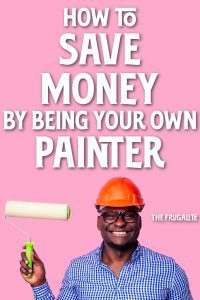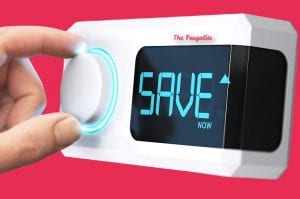(Psst: The FTC wants me to remind you that this website contains affiliate links. That means if you make a purchase from a link you click on, I might receive a small commission. This does not increase the price you’ll pay for that item nor does it decrease the awesomeness of the item. ~ Daisy)
By the author of What School Should Have Taught You: 75 Skills You’ll Actually Use in Life
I’ve been doing a bit of painting of late, and if you’re at the point where you’re thinking you need to do the same for your place, you’re probably considering hiring a painter.
That’s always an option, of course, but if you’re hoping to save several hundred dollars (if not thousands, depending on how much you have to paint), you can most certainly do your painting yourself as well. Here are some of the things that I do when it comes to painting that have not only made the job easier but have helped me to save a bit of money in the process as well.
Spend the money on the blue painter’s tape
Yeah, you may be able to find super cheap white painter’s tape out there but do not waste your money. Every single time that I’ve used this stuff I end up having a ridiculously hard time peeling it all off. Instead of peeling off in one nice, continuous strip like the blue painter’s tape does, this stuff just likes to tear off in little, teeny pieces.
You might think that this won’t be that bad and that you can handle that, but it’s not just that this tape comes out in pieces. It’s also that the little piece that’s going to be left behind is going to be too small for your fingers to grab and is going to be cemented into the far corner of that door frame you were working on. The only way you’re then likely able to get it out is with a razor blade or maybe a pair of needlenose pliers.
If all you’ve painted is a single door framed, this might not be so bad, but if it’s an entire house we’re talking about that you now have to move through with a razor blade while on your knees by every piece of floor trim, it quickly proves to be a pain in the butt.
So, I think that the time saved using the blue stuff is well worth the money.
(Also, spend the time with a quality taping job. My mom always taught me this is the key to a nice paint job. She’s both smart and right.)
Purdy rocks.
These are the only type of brushes I typically buy anymore. The bristles are high quality, and I don’t have to worry about stray hairs causing weird mistakes in my paint that I then have to figure out how to fix. I like buying these from big box stores in the three packs as this seems to be the most economical means of getting the brushes I need.
If you buy each brush separately, it ends up costing way more. Three packs of Purdy Brushes will make you happy while you paint.
Take care of your paintbrushes.

Paint brushes are expensive. You don’t want to have to go out spending another $20 for each and every room you have because you destroy a brush every time you complete one.
Don’t just wrap the thing in a plastic bag and assume you can come back later. You’re going to forget about it and it’s going to dry. Take the time now to clean it out and hang it up to dry. You can easily save yourself $80 on brushes for a house doing this.
Harbor Freight for the drop cloths
Painting over plastic sheeting is a slippery, obnoxious mess, so I like painting over cloth drop cloths. You will pay significantly less picking these up at your local Harbor Freight. It’s a piece of cloth that’s going to catch paint – there’s no need to pay top dollar here.
Roll in style.
You’re probably not thinking about spraying your house, so that means the fastest means you have available to you to paint that wall is to roll it. Here are the things I’ve discovered here:
The Purdy extendable roller stick (with the designated roller) is absolutely awesome. It will save you a lot of reaching overhead, a lot of time, and a lot of effort. I 100% think that you should invest in both of these if you’re looking at a significant amount of painting anytime in the future. And it makes you look like a pro painter, added bonus!
You won’t be happy with flat paint on your walls.
Flat paint on walls looks like trash in about three months. It’ll be covered in scuffs and marks from top to bottom, almost magically. Get something that isn’t magnetic to dirt. Personally, I’m a fan of eggshell paint sheens, especially when they’re the easy-to-wipe-off kinds. If you’re going to spend the time and money painting, do it so that it looks good for as long as possible.
Designated paint stores are stupid expensive.
Big box hardware stores have the most reasonably priced paint if you aren’t a contractor. If you are a contractor, you can get phenomenal prices at designated painter stores. If you’re not, you can easily spend $70+ a gallon at these places. Seriously.
In contrast, if you head to the big box hardware store, you’re going to be spending $30-50 for a gallon of paint that, I think, works just as well.
Kilz it
Kilz is cheap. Colored paint is not. If you have an obnoxiously colored wall you want to cover up and paint some other color, Kilz it with a coat or two first. If you don’t, and you decide to paint several coats of your fancy paint over it, you’re going to either A) be unhappy with the end result, or B) spend money you didn’t have to spend using “fancy” paint.
Kilz it first, and then use your fancy paint.
Painting is a lot of work, so make your work count.
It’s taken me a lot of years of working out the kinks in my painting but following the above rules has helped me to paint nice-looking rooms as quickly, cheaply, and efficiently as possible.
Who knows? Maybe it’ll help you too.
What are your thoughts on the subject? Do you have any tips for being your own painter? Do you have anything else to add? What’s your favorite painter’s tape? Let us know in the comments below.
About Aden
Aden Tate is a regular contributor to TheOrganicPrepper.com and TheFrugalite.com. Aden runs a micro-farm where he raises dairy goats, a pig, honeybees, meat chickens, laying chickens, tomatoes, mushrooms, and greens. Aden has four published books, What School Should Have Taught You, The Faithful Prepper, An Arm and a Leg, The Prepper’s Guide to Post-Disaster Communications, and Zombie Choices. You can find his podcast The Last American on Preppers’ Broadcasting Network.











1 thought on “How to Save Money By Being Your Own Painter”
Nice article! Here’s a tip: For roller covers, get the shortest nap you can. That big squishy nap will soak up a bunch of paint and not let it all go again and it won’t go on the wall as well. That’s one thing I learned about painting.